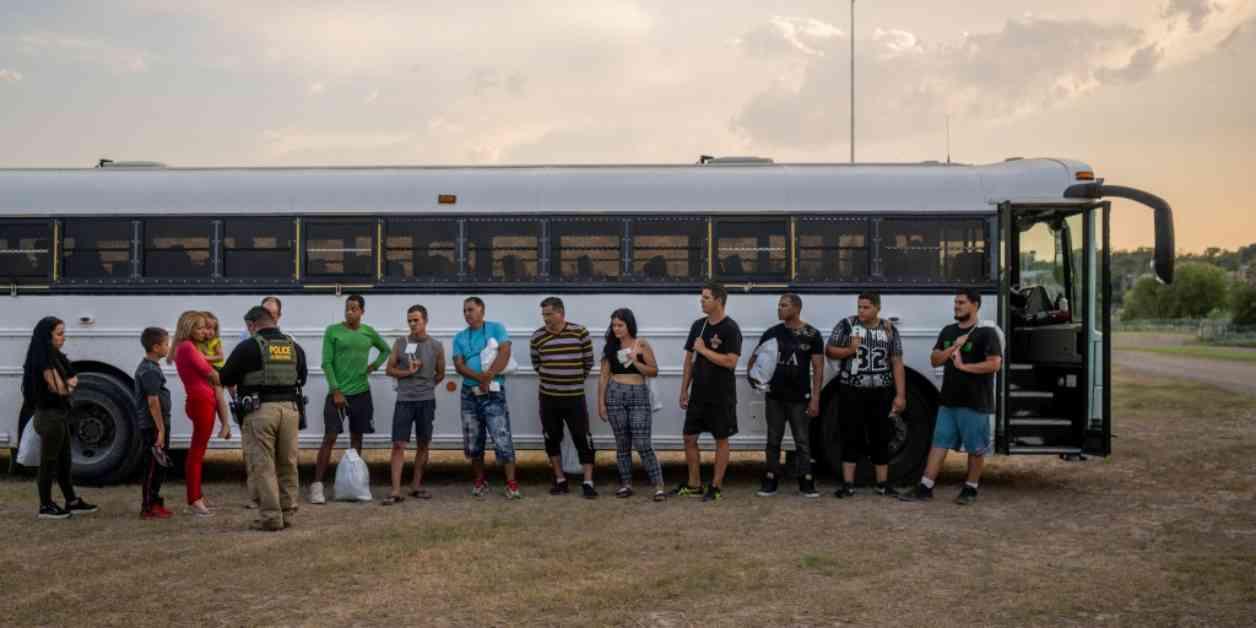Texas Gov. Greg Abbott’s Pledge to Continue Transporting Migrants North Despite Shortage
Republican National Convention delegates erupted in applause last month when Texas Gov. Greg Abbott reiterated his commitment to sending buses full of migrants to sanctuary cities across the country. Abbott’s vow to continue transporting migrants north has been met with both support and criticism, as the number of apprehensions at the southern border has significantly decreased in recent months.
Decrease in Migrant Apprehensions
Officials and migrant shelter operators in Texas and several major cities across the U.S. have reported a noticeable decline in the number of migrants being apprehended at the southern border. In May, approximately 117,000 migrants were stopped, a significant drop from the record 300,000 apprehensions in December. This downward trend continued in June, with about 84,000 migrants apprehended, marking the lowest monthly total since President Joe Biden took office in 2021.
The decrease in migrant apprehensions has had a direct impact on the frequency of buses transporting migrants to sanctuary cities. Josh Goldfein, a staff attorney for the Legal Aid Society of New York, noted that buses are now coming much less frequently due to the reduced number of migrants attempting to cross the border. The decline in apprehensions has been attributed to a combination of factors, including a crackdown by Mexican authorities on U.S.-bound migrants and Biden’s executive action in June, which restricted who can claim asylum at the southern border.
Gov. Abbott’s Border Mission
A spokesperson for Gov. Abbott acknowledged that there are now fewer migrants available to transport out of state, but attributed the decline to the governor’s actions in Texas. According to Andrew Maheris, the spokesperson, Texas has reduced illegal crossings into the state by 85% thanks to their historic border mission. This reduction in illegal crossings has directly resulted in fewer buses departing for sanctuary cities.
Operation Lone Star
Abbott initiated the busing of migrants in 2022 as part of Operation Lone Star, an $11 billion program aimed at addressing the migrant surge in Texas. Last year, large numbers of migrant buses departed from border towns such as Del Rio and McAllen. However, in recent months, there has been a noticeable decrease in the frequency of buses leaving these cities, as reported by local officials and migrant shelter operators.
The last buses sponsored by Abbott to leave Laredo and Brownsville rolled out in January, with a sharp decline in the number of buses leaving El Paso in recent months. Bill Irvin, of the nonprofit Opportunity Center for the Homeless, stated that while the opportunity exists for buses every Wednesday in El Paso, there has been a significant decrease in the need for transportation due to low census numbers in shelters.
Fluctuations in Bus Departures
A spokesperson for the Texas Division of Emergency Management, which manages bus logistics, explained that bus departures have fluctuated over time due to the number of individuals processed and released by the federal government in overwhelmed border communities. Seasonal and weather conditions have also played a role in the fluctuation of bus departures.
Impact on Receiving Cities
Multiple cities that had been receiving buses of migrants from Texas have reported a cessation in arrivals since January. Philadelphia, Washington D.C., Los Angeles, Chicago, Denver, and New York are among the cities that have not seen any Abbott buses this year. In some cases, cities have imposed restrictions on the arrival of buses, leading to a shift in transportation methods for migrants.
In New York, Mayor Eric Adams imposed restrictions on Abbott buses in December and filed a lawsuit against bus companies bringing migrants to the city from Texas. As a result, buses began dropping off migrants in New Jersey, who were then given train tickets to Manhattan. However, even this method of transportation has declined since Biden’s executive action in June.
Collaboration and Coordination
Immigration activist Power Malu, who played a key role in welcoming migrants to New York, coordinated efforts with a network of advocates in Texas via an encrypted app. Malu noted that while the buses from Abbott garnered headlines, a significant portion of the influx of migrants into New York during the surge came through airports and migrants purchasing their own bus tickets.
Impact on Shelters
The decrease in migrant crossings at the border has had repercussions on shelters in Texas border towns, with some organizations having to downsize due to the lack of intakes. Victor Trevino Jr., an attorney for the mayor of Laredo, highlighted the challenges faced by NGOs in adjusting to the reduced number of migrants crossing the border.
Conclusion
As the number of migrants apprehended at the southern border continues to decline, the transportation of migrants to sanctuary cities by Gov. Abbott’s administration has also decreased significantly. The impact of this reduction is being felt in both Texas and receiving cities across the U.S., with shelters and organizations having to adapt to the changing circumstances. The future of migrant transportation remains uncertain as border policies and enforcement efforts continue to evolve.



























